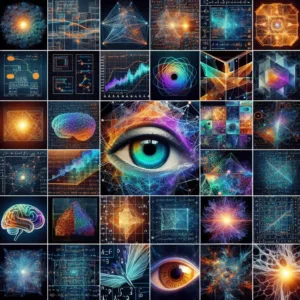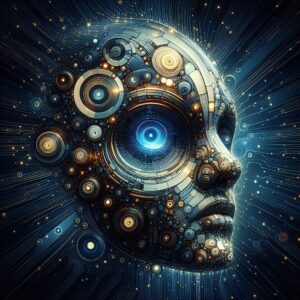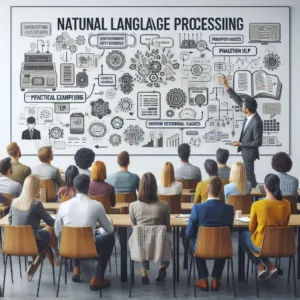In the expansive realm of artificial intelligence (AI) and machine learning, developing a neural network represents a significant milestone, particularly for beginners. This tutorial aims to elucidate the intricacies of this process, offering clear explanations and informative guidance to help you create your inaugural neural network. Whether you are a student, a budding developer, or simply have an interest in AI and machine learning, this guide is designed to navigate you through the fundamentals of neural network development.
Definitions and Fundamental Concepts: Neural Network
- Machine Learning (ML): Machine learning is a subset of artificial intelligence that focuses on enabling machines to learn from data without being explicitly programmed. Instead of providing explicit instructions, machine learning algorithms are designed to identify patterns and make predictions or decisions based on data.
- Artificial Intelligence (AI): Artificial intelligence refers to the simulation of human intelligence in machines programmed to replicate cognitive functions such as learning, problem-solving, and decision-making. AI encompasses a wide range of technologies and applications, including machine learning, natural language processing, computer vision, and robotics.
- Differences between AI and Machine Learning: While artificial intelligence is the broader concept of creating machines capable of intelligent behavior, machine learning is a specific approach within AI that focuses on algorithms learning from data. AI aims to create intelligent machines, while machine learning is a method used to achieve that goal by enabling machines to learn from data.
Significance of Neural Networks:
Neural networks play a crucial role in both artificial intelligence and machine learning. Inspired by the structure and function of the human brain, neural networks are computational models composed of interconnected nodes (neurons) that work together to process and analyze complex data. Neural networks excel in tasks such as pattern recognition, classification, regression, and sequence generation. Their ability to learn from data and adapt to different scenarios makes them indispensable tools in various fields, including computer vision, natural language processing, speech recognition, and more. Additionally, deep learning, a subfield of machine learning that leverages deep neural networks with multiple layers, has revolutionized AI by achieving state-of-the-art performance in various tasks, further highlighting the importance of neural networks in advancing the fields of AI and machine learning.
Overview of a Neural Network:
- What is a Neural Network? A neural network is a computational model inspired by the structure and functioning of the human brain. It consists of interconnected nodes called neurons, organized in layers. These networks are capable of learning from data, making them powerful tools for tasks such as pattern recognition, classification, regression, and sequence generation.
- Essential Components of a Neural Network:
- Neurons: Neurons are the basic building blocks of a neural network. Each neuron receives input signals, processes them using an activation function, and produces an output signal, which is then transmitted to neurons in the next layer of the network.
- Layers: A neural network is typically organized into layers, which are interconnected clusters of neurons. The most common types of layers include:
- Input Layer: Receives input data and passes it to the next layer.
- Hidden Layers: Located between the input and output layers, these layers are responsible for extracting features from the input data through complex transformations.
- Output Layer: This layer produces the final output of the network, such as a classification or regression prediction.
- Activation Functions: Activation functions determine the output of a neuron based on its input. They introduce nonlinearities into the network, enabling it to learn complex patterns in the data. Common activation functions include sigmoid, tanh, ReLU (Rectified Linear Unit), and softmax

- Artificial Neural Networks (ANNs): Artificial neural networks are the most basic type of neural network, consisting of interconnected layers of neurons. They are widely used for tasks such as classification, regression, and clustering.
- Convolutional Neural Networks (CNNs): Convolutional neural networks are specifically designed for processing structured grid data, such as images. They use convolutional layers to automatically learn spatial hierarchies of features from the input data, making them highly effective for tasks like image classification, object detection, and image segmentation.
- Recurrent Neural Networks (RNNs): Recurrent neural networks are designed to handle sequential data, where the order of inputs matters. They have loops in their architecture, allowing them to maintain a memory of past inputs and process sequences of data. RNNs are commonly used in tasks such as natural language processing, speech recognition, and time series prediction.
These types of neural networks represent just a few examples of the diverse range of architectures and applications within the field of artificial intelligence and machine learning. Each type has its strengths and weaknesses, making them suitable for different types of tasks and data.
Data Preparation:
- Collection and Preprocessing of Training Data:
- Collection: The first step in data preparation is gathering relevant data for the task at hand. This may involve collecting data from various sources such as databases, APIs, or data repositories.
- Preprocessing: Once the data is collected, it often needs to be preprocessed to ensure quality and suitability for training. This could include tasks such as cleaning the data to remove noise or outliers, handling missing values, and encoding categorical variables into numerical representations.
- Data Normalization:
- Normalization: Data normalization is a crucial step in preprocessing that involves scaling the features of the data to a similar range. This ensures that each feature contributes equally to the learning process and prevents features with larger scales from dominating the training process. Common normalization techniques include min-max scaling and standardization (z-score normalization).
- Division of Data into Training, Validation, and Test Sets:
- Training Set: The training set is used to train the neural network model. It consists of a subset of the available data and is often the largest portion of the dataset.
- Validation Set: The validation set is used to tune hyperparameters and evaluate the performance of the model during training. It helps prevent overfitting by providing an independent dataset that the model hasn’t seen during training.
- Test Set: The test set is used to evaluate the final performance of the trained model. It serves as a fair measure of the model’s generalization ability to unseen data. The test set should be kept separate from the training and validation sets throughout the entire training process to ensure a fair evaluation.
- Division Process:
- Randomization: Before dividing the data, it’s important to randomize the order of the samples to prevent any inherent order or patterns from influencing the training process.
- Partitioning: The data is divided into training, validation, and test sets according to a predefined ratio, such as 70% for training, 15% for validation, and 15% for testing. The exact ratios may vary depending on the size and nature of the dataset, as well as specific requirements of the task.
- Stratification (Optional): In classification tasks, it’s often beneficial to ensure that the distribution of classes is similar across the training, validation, and test sets. This can be achieved through stratified sampling, which maintains the class proportions when splitting the data.
By following these steps for data preparation, practitioners can ensure that their neural network models are trained on high-quality data and are evaluated using robust evaluation methodologies, ultimately leading to more reliable and generalizable results.
Building Your First Neural Network:
- Choosing the Framework or Library:
- TensorFlow, Keras, PyTorch, etc.: The choice of framework or library depends on factors such as nature, flexibility, and specific requirements of the project. Popular options include TensorFlow, which provides a high-level API called Keras for building neural networks, and PyTorch, known for its dynamic computational graph and ease of use.
- Configuration of the Neural Network:
- Number of Layers and Neurons: The architecture of the neural network, including the number of layers and neurons in each layer, depends on the complexity of the problem and the characteristics of the data. Beginners often start with a simple architecture, such as a single hidden layer with a moderate number of neurons, and gradually increase complexity as needed.
- Activation Functions: Activation functions introduce nonlinearity into the network and play a significant role in its ability to learn complex patterns. Common choices include ReLU (Rectified Linear Unit) for hidden layers and softmax for the output layer in classification tasks.
- Model Compilation:
- Choice of Loss Function: The loss function measures the difference between the predicted output and the actual target values during training. The choice of loss function depends on the task at hand, such as mean squared error for regression or categorical cross-entropy for classification.
- Optimizer: The optimizer is responsible for adjusting the weights and biases of the neural network based on the gradients of the loss function with respect to these parameters. Popular optimizers include stochastic gradient descent (SGD), Adam, and RMSprop.
- Metrics: Metrics are used to evaluate the performance of the model during training and validation. Common metrics include accuracy for classification tasks and mean squared error for regression tasks.
- Training the Model:
- Adjusting Weights and Biases: During training, the neural network learns to adjust its weights and biases using an optimization algorithm (e.g., SGD) to minimize the loss function. This process involves forward propagation to compute predictions, backward propagation to compute gradients, and parameter updates using the optimizer.
- Model Evaluation:
- Using Validation Data: After training, the model is evaluated using validation data to assess its performance on unseen examples. This helps identify overfitting and fine-tune hyperparameters. The evaluation metrics chosen during model compilation are used to measure performance on the validation set.
By following these steps, beginners can build and train their first neural network, starting with a basic configuration and gradually experimenting with different architectures, optimizers, and hyperparameters to improve performance on their chosen task.
Optimization and Improvement of the Model: Neural Network
- Hyperparameter Tuning:
- Grid Search or Random Search: Hyperparameter tuning involves finding the optimal values for parameters such as learning rate, batch size, and number of neurons/layers. Methods like grid search or random search can be used to systematically explore different combinations of hyperparameters and identify the ones that yield the best performance on the validation set.
- Automated Hyperparameter Optimization: Alternatively, automated methods such as Bayesian optimization or genetic algorithms can be used to efficiently search the hyperparameter space and find optimal configurations.
- Regularization Techniques:
- L1 and L2 Regularization: L1 and L2 regularization are techniques used to prevent overfitting by adding penalty terms to the loss function. These penalty terms encourage the model to learn simpler patterns by penalizing large weights (L2) or promoting sparsity in the weights (L1).
- Dropout: Dropout is a regularization technique that randomly drops a fraction of neurons during training, forcing the network to learn redundant representations and reducing reliance on specific neurons. This helps prevent overfitting and improves generalization.
- Early Stopping: Early stopping involves monitoring the performance of the model on the validation set during training and stopping the training process when performance starts to degrade. This prevents the model from overfitting to the training data by halting training before it begins to memorize noise.
- Measures to Avoid Overfitting:
- Cross-Validation: Cross-validation is a technique used to assess the generalization performance of a model by dividing the data into multiple subsets (folds). The model is trained on different combinations of training and validation sets, and performance metrics are averaged over folds to obtain a more reliable estimate of performance.
- Data Augmentation: Data augmentation involves generating new training examples by applying random transformations such as rotation, translation, or flipping to the existing data. This increases the diversity of the training set and helps the model generalize better to unseen examples.
- Model Simplification: Simplifying the model architecture by reducing the number of layers or neurons can help prevent overfitting, especially when dealing with limited training data or noisy datasets.
By incorporating these optimization techniques and measures to avoid overfitting, practitioners can improve the performance and generalization ability of their neural network models, leading to more reliable and robust results on real-world tasks.
Conclusion:
Embarking on the journey of building a neural network may appear intimidating at first, but armed with a firm grasp of fundamental concepts and systematic steps, it becomes achievable even for beginners. Throughout this tutorial, we’ve delved into the essential aspects of building a neural network, empowering you to take that crucial first step into the domains of artificial intelligence and machine learning.
By diligently exploring and experimenting, you have the opportunity to expand your understanding and develop advanced proficiency in this captivating field. With each endeavor, you’ll uncover new insights, refine your skills, and contribute to the ever-evolving landscape of AI and machine learning. Keep learning, keep improving, and embrace the boundless possibilities that lie ahead in your neural network journey.
AI Resources and Insights
- AI Art Generator on Canva: Explore how to create art with AI on Canva.
- NVIDIA Startups: Discover opportunities for startups with NVIDIA.
- Konverge AI: Learn how Konverge AI can transform your business.
- Heygen Pricing: Check out Heygen’s pricing for AI solutions.
- DataCentric AI: Explore the latest AI trends on DataCentric AI.
- Google Cloud Conversational AI: Discover Google Cloud’s conversational AI solutions.
- Amazon Web Services (AWS): Explore Amazon Web Services’ AI services.
- Marketing AI Institute: Learn more about AI-powered marketing at the Marketing AI Institute.
- Harvard Business Review – AI Marketing Strategy: Read about designing an AI marketing strategy on Harvard Business Review.
- SAS – AI Marketing Future: Discover what the future holds for AI marketing on SAS.
- Sprout Social AI Marketing Tools: Explore AI marketing tools from Sprout Social.
- Pixlr Image Generator: Create unique images with Pixlr’s image generator.
- Creative Writing Prompts on AI UpTrend: Explore creative writing prompts powered by AI on AI UpTrend.
- AI Trends on AI UpTrend: Discover the latest AI trends on AI UpTrend.
- AI Insights on AI UpTrend: Explore the latest advancements in AI on AI UpTrend.
- AI Tools on AI UpTrend: Discover a variety of AI tools on AI UpTrend.
- AI Tutorials on AI UpTrend: Explore AI tutorials to deepen your knowledge on AI UpTrend.






























